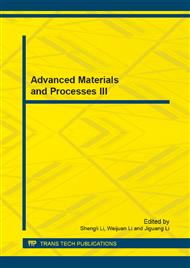p.318
p.323
p.327
p.331
p.336
p.342
p.351
p.355
p.359
Electron Microscopic Analysis of 30CrMnSi Steel Surface Layers after Hot Deformation
Abstract:
Using electron microscopy were investigated character of change microdiffraction pattern of fragmented substructure, the relationship between average size micrograins, which forming the diffraction pattern, and the point reflections number on the ring. Also the integrated degree of plastic deformation was assessed in the roll surface layers, made of steel 30CrMnSi during hot deformation. It was shown that the fragments generated during steel deformation considerably disoriented with respect to each other. Formed by heat treatment steel fragments practically is not disoriented. Found that average size of fragments to be achieved in layer at distance of 2 mm from roll surface, for anisotropic fragments amounts to 0.27×0.66 μm, for isotropic - 0.43 μm, average size of fragments - 0.44 μm. Here plastic deformation degree ε0.70. Found that in layer located at distance of 0.5 mm from roll surface, anisotropic fragments have size 0.25×0.56 μm value, for isotropic - 0.39 μm, average fragment size - 0.40 μm. Here plastic deformation degree achieved value ε0.75. It is shown that on roll surface are present only isotropic fragments with average size 0.22 μm. Corresponds to it plastic deformation degree ε0.85.
Info:
Periodical:
Pages:
336-341
Citation:
Online since:
September 2013
Authors:
Price:
Сopyright:
© 2013 Trans Tech Publications Ltd. All Rights Reserved
Share:
Citation:


